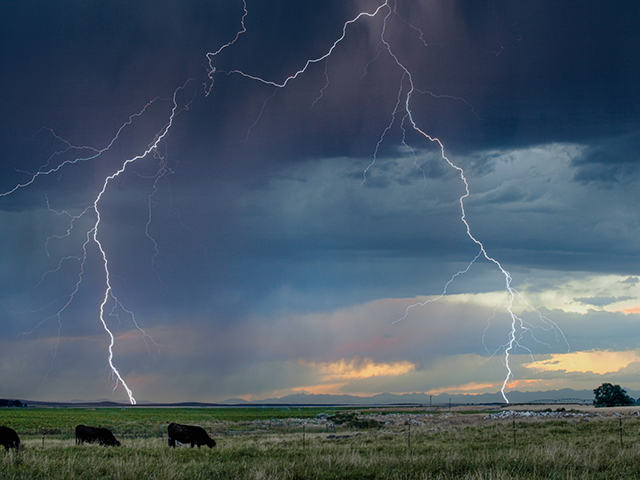Ask the Vet
Lightning Strikes Common Cause of Cattle Deaths
READER: We found a cow dead in the middle of the pasture with no signs of struggle. She was badly bloated. All other cows in the pasture were fine. We had a thunderstorm the night before we found her, but there is also a good bit of clover in this pasture. She was at least 100 yards from a tree or a fenceline. Is there some way to know what killed her?
Dr. McMillan: Physical signs on the carcass or in the environment are thought to be present in more than 90% of cases of death from lightning. These can include linear singe marks, especially on the insides of the legs. There is often damage to a tree or a fence pole, or disturbed ground. There is almost never any sign of struggle. Death by lightning strike is almost always instantaneous. Cattle may have grass in their mouth, normal rumen content and fecal material. In lightning-strike cases, rigor mortis quickly sets in and passes. Rumen distension is from free gas rather than frothy bloat commonly seen with clovers and other bloat-inducing forages.
In the case of insured animals, always take pictures at the death site. An examination of the animal prior to moving it may be helpful. A necropsy by either your local veterinarian or a state diagnostic lab can be helpful if done soon after death. Common findings at necropsy when lightning is the cause of death include poorly clotted or unclotted blood, hemorrhagic marks and/or blood clots in the trachea, nasal turbinates and sinuses. Lungs of cattle killed by lightning are not compressed as they typically are with bloat. The lungs, liver, kidneys and other organs are congested with bloody material and have hemorrhagic areas on their surfaces. Poorly clotted blood tends to pool in extremities like the head, neck, front and rear legs.
I recommend contacting your local USDA Farm Service Agency. The Livestock Indemnity Program provides assistance to producers for livestock deaths that exceed normal mortality rates from eligible disaster events such as hurricanes, floods, blizzards, wildfires, tornadoes, lightning, disease, extreme heat, extreme cold and earthquakes.
P[L1] D[0x0] M[300x250] OOP[F] ADUNIT[] T[]
READER: In your column in the summer issue of Progressive Farmer, you discussed weaning vaccinations, and you seemed to not like killed vaccines. This is what I have always used, so I don't have to worry about abortions or the stress of modified live vaccines. Am I wrong?
Dr. McMillan: Killed vaccines can be very effective tools for a lot of herd-health programs. I recommend them in many cases. But, let's revisit our discussion of modified live vaccines (MLV). All killed vaccines and some MLVs contain adjuvants that enhance the immune response to vaccine antigens. Adjuvants in killed vaccines are typically more aggressive and potentially more stressful than those in MLVs. In my opinion, based on my reading and those experts with whom I consult, MLVs are quicker acting and produce more complete, longer-lasting immune responses. Used properly, they are as safe as killed vaccines, and I believe less stressful.
With highly stressed cattle such as stockers, I like intranasal vaccines (IN) in most cases. This is the least stressful way to vaccinate, response is quick, and local immunity is produced in nasal passages that can be very effective in preventing respiratory disease. INs prime the immune system and increase effectiveness of subsequent MLVs. Killed vaccines require a booster in two to four weeks before significant immunity is produced.
I also really like IN vaccines for young cattle in cow/calf operations. When a killed vaccine is given to calves, they produce little, if any, immunity until the booster. If the interval is too long before that booster, there is little or no effect. The IN vaccine goes to work immediately.
So, let's review the advantages of MLVs. They are less expensive, begin producing immunity immediately after dosing and produce the highest levels of immunity. Booster intervals are less critical with an MLV, and I believe they are less stressful overall unless you are working highly stressed cattle with minimal or no prior preventive care.
Killed vaccines can be an excellent option in a cow/calf operation, especially if you use MLVs in calves with a final booster 45 to 60 days prior to breeding heifers and a high-quality killed vaccine in the cow herd annually. This is a case where the killed vaccine does not require a booster. It's important to consult with your local veterinarian about all vaccine selections, especially killed vaccines. Remember, all vaccines are not created equal.
**
-- Please contact your veterinarian with questions pertaining to the health of your herd. Every operation is unique, and the information in this column does not pertain to all situations. This is not intended as medical advice but is purely for informational purposes.
-- Write Dr. Ken McMillan at Ask The Vet, 2204 Lakeshore Dr., Suite 415, Birmingham, AL 35209, or email vet@progressivefarmer.com.
[PF_0821]
(c) Copyright 2021 DTN, LLC. All rights reserved.



